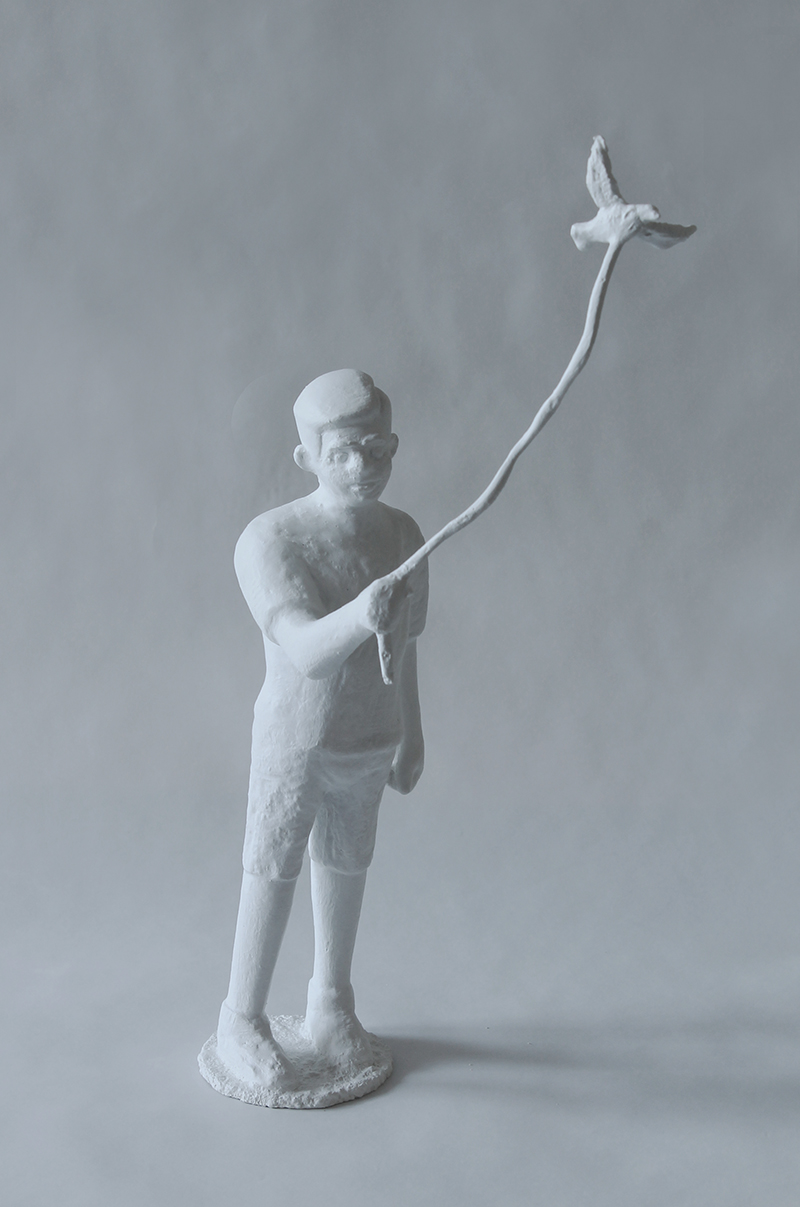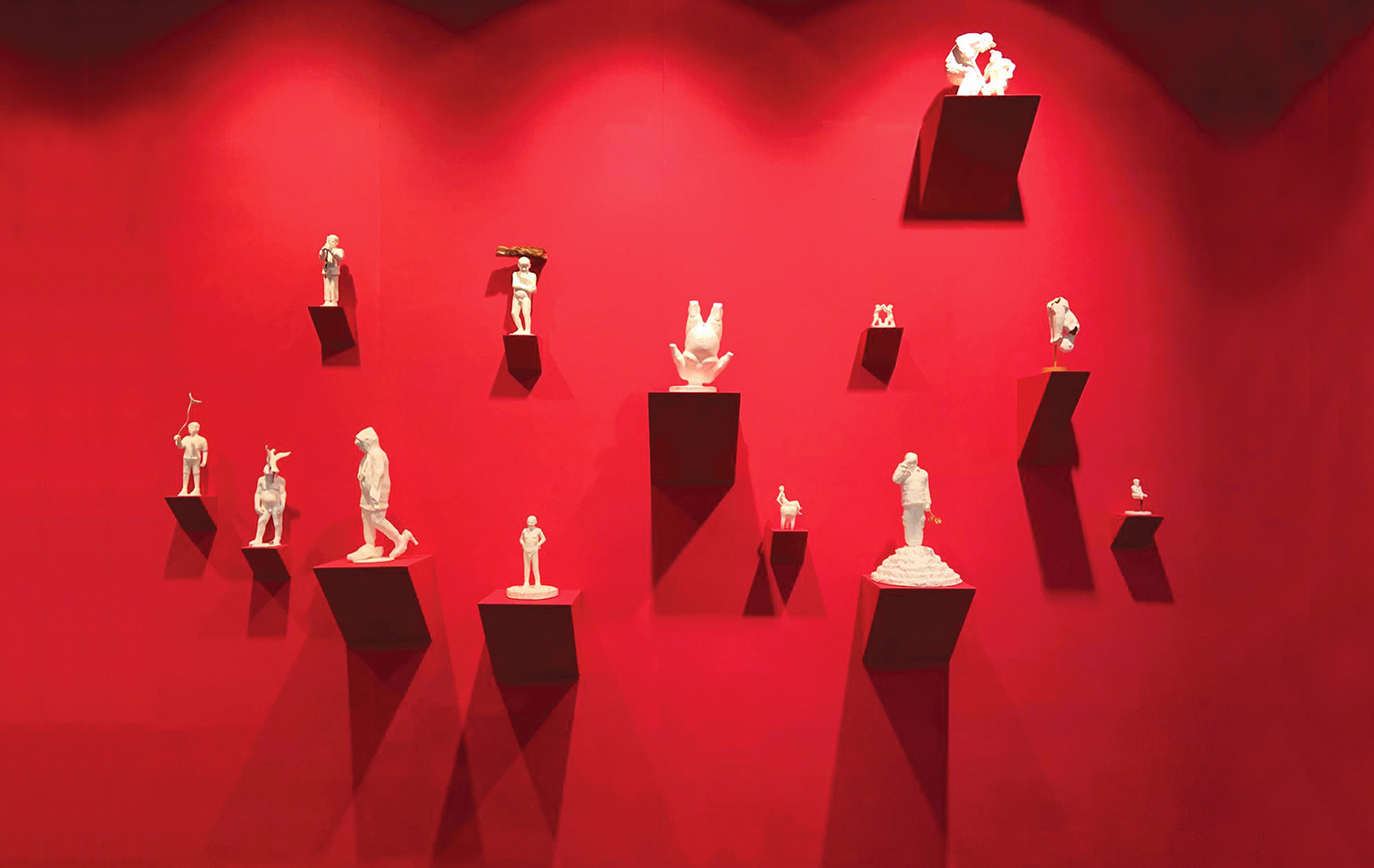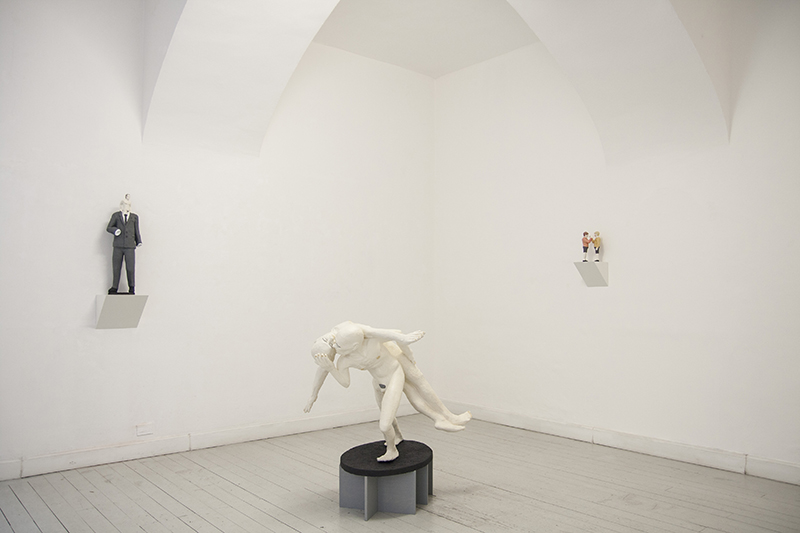Contemporary artist Miro Trubač delivers paradoxes and stalemates using humour and irony. An Asian Curator artist interview
My work is characterised by an interest in relationships. Relationships influence everyone and are a major aspect of social interaction. Every relationship enhances our personality and helps us to find our place in society and understand ourselves. I have decided to return to figural sculpture, yet I am not trying to burden it with ideology, politics or purely conceptual thinking.

Miro Trubaü. Work in process.
Please tell us a little about yourself, what brought you to the world of art and how did you start?
It is difficult for me to give you an unbiased answer. People unwittingly choose many things and show a clear disposition toward them since birth.
When I was a little boy I loved toys, especially comic-book characters. I drew my favourite superheroes and movie characters. I was fascinated by the anatomy of the human body, especially by its articulation and compactness.
The turning point came when I was about 12 years old and began to show a keen interest in art. During a school trip I saw a monumental sculpture of the leading Slovak sculptor Jozef Jankovič created between 1967 and 1969 called Victims’ Warning! It is a memorial to the victims of World War II. Jankovič captured the essence of the theme in a captivating way. Naturally, I wanted to meet Professor Jankovič in person and become his student at the Academy of Fine Arts and Design in Bratislava, where he had his own studio. Eventually, I succeeded.
What is the primary role of an artist? How do you describe yourself in the context of challenging people’s perspectives via your work and art?
Artists have an important role in society since art is a discipline with a fragile core. Art teaches us to perceive everything through the heart. Art can anticipate and predict some events even before they happen. Every age carries a message. Artists have the rare gift of capturing the spirit of the age and materialise it in the work of art. They can express emotions with the language of art and retell the narrative. Art is an incredibly powerful tool.
The narrative as the basis of emotional conflict has always been important to me. Personal experience, at least in my case, plays a significant role. I introspect on my memories, trying to visualise them again, and by their careful transcoding I am trying to create new values. I perceive my work as an open narrative in which differently combined works create a story. I think about the situations that shape my system of values.

Freedom (J.R.D. series). 2015. coloured plaster. 40 x 105 x 60 cm. Photy by Danica Balgav†
How do you deal with the conceptual difficulty and uncertainty of creating work?
I take uncertainty and doubt as part of the creative process, as natural self-evaluation. I always attempt to achieve two things – to keep the balance between content and form. If this balance is upset, the entire work is destroyed. Initially, there is always an idea, and I explore ways of realising it. I work in 3D programs and compose the work. Subsequently, I reflect on the material and the scale. This process of search sometimes takes a year to complete. I enjoy walks with my dog, the time when I can quietly reconsider the next stage.
Is there any topic lately that you would like to be mentored on?
Recently I have been working on a series called OFF White. I recycle old moulds and then cast the segments, re-shape and join them to form coherent wholes. Finally, I incorporate found objects in these experiments with 3D printing, something I would like to develop in the future.
I am concerned about the growing right-wing extremism and a desire for the political destabilisation of Europe because it is my home and I want to understand historical legacies that have influenced our development.

The Candle March (J.R.D. series). 2015. Mixed media, LED light. 50 x 112 x 40 cm. Photo by Danica Balgav†
What would you call your style?
I think my style could be described as laminated and collaged figural sculpture.
Let’s talk about the evolution of your practice over the years. Tell us about your commitment to your current medium.
My work can be divided into two lines. The first is personal mythology – I draw ideas from my family environment and household. The second embraces broader political and social themes concerning everyone. I am interested in paradoxes and stalemates, trying to express them with a touch of humour and irony. It is my ambition to bring sculpture closer to people and enable them to identify themselves with art. I therefore attempt to free sculptures from heroism and ideology, and am more interested in the influence of history on our lives today.
I mostly create small and medium size sculptures. Small sculptures look like toys and I feel that this makes them more perceptible to people.
Let’s talk about your career, or if you prefer artistic journey. What were your biggest lessons and hiccups along the way?
I arrived on the art scene ten years ago. My artistic development was influenced by three moments in my life.
I studied in the Department of Sculpture, Object, Installation at the Academy of Fine Arts, and tried to explore the possibilities of sculpture and extend my own boundaries.
My father died of a work-related accident while I was still a student. Subsequently my role of the son changed into the role of the man with more responsibilities. After graduation I was employed as an art teacher at the primary art school and worked with children. This reflected in my work, which became more expressive. I am extremely grateful for that.

Learn to Fly (OFF white series). 2019. Mixed media. 16 x 35 x 10 cm. Picture courtesy A Pick Gallery.
How does your audience interact and react to your work? What are you looking for when you look at other artists’ work? Which shows, performances and experiences have shaped your own creative process? Who are your maestros?
The most common response to my work is that it is humorous and ironic. I have never had the impression that spectators would be outraged by too much sarcasm and irony in my work.
It is not easy to unambiguously answer the question about “what I am looking for in the works of other artists”. I think it is the first impression that draws my attention and then I strive to penetrate deeper into the work. I can definitely say that the idea and message of the work is more important to me.
Personally, I am greatly inspired by literature, music and film. For example, I try to express the lyrics of a song in sculpture – to materialise words in a static form. I attempt to express the same emotions as those aroused by listening to a song.
The exhibition Like Life – Sculpture, Color and the Body at the Metropolitan Museum of Art in New York was an inspiring experience. It focussed on the use of colour and image of the human body in sculpture from 1300 to the present day. The display was not arranged chronologically, but depended on the subject matter.
What was your first sale? Do you handle the commercials yourself or is it outsourced to a gallery or an agent?
I am currently represented by A Pick Gallery from Turin, Italy. I see the sale of my artworks as a positive impulse, a strong moment that someone has identified himself with the idea I tried to express so much that he bought the piece. At the same time, I have to say that I do not stick emotionally to individual works, and concentrate most of my energy on works in progress.

Portrait of Miro Trubaü. Photo by Oliver Ondr†Á
Think of the biggest professional risk you’ve taken. What helped you take that risk?
In 2017 I had the opportunity to participate in the group exhibition Personal Structures – Open Borders, which was the accompanying event of the 57th Venice Biennale. I could only choose one work. However, I decided not to exhibit anything from my portfolio, but create a new work. It was a bit of a risk, but I felt I had to make an entirely new piece. I was driven by passion, by a desire for a new experience, and I did not even think of how it would be received. Eventually, my interpretation of the biblical figure of Judas was favourably received at the exhibition and also in Slovakia. At present, the statue of Judas is in the collection of the Gallery of Spiš Artists in Spišská Nová Ves.
What is the best piece of advice you have received?
I remember that while I was still a student, one professor told me that I should be more confident. However, my mother tells me that I should always be myself in every situation and do things the way I feel them.
Tell us about your studio, what kind of place is it? Could you describe your usual working day in the studio?
The studio is part of the place where I live. It suits me because I don’t have a precise daily work schedule as I prefer working at night. I like the end of the day when everything becomes quiet and I’m just starting. I know that I won’t be disturbed by anything and anyone, and can fully concentrate on my work.

OFF white series – presentation at Art Verona 2019. Picture courtesy A Pick Gallery.
How do you resolve the conflict between the commercial and the creative? How does your interaction with a curator, gallery or client evolve?
My gallery does not interfere with my work. I have absolute creative freedom. I appreciate cooperation with a curator, but I can see the difference between collaboration in a solo show and group exhibitions. Solo exhibitions are always more challenging, involving more careful preparation and much closer cooperation with the curator to create a meaningful and balanced exhibition. In my opinion, solo exhibitions should display the artist’s development and indicate new ideas.
The curator of a group exhibition, however, has a clear idea of the concept and communicates with me when my artistic expression corresponds with his or her concept. The result of successful cooperation is a compromise, dialogue and willingness to listen to the other side.
Let’s talk about your frameworks, references and process. What inspires you?
My work is characterised by an interest in relationships. Relationships influence everyone and are a major aspect of social interaction. Every relationship enhances our personality and helps us to find our place in society and understand ourselves. I have decided to return to figural sculpture, yet I am not trying to burden it with ideology, politics or purely conceptual thinking. I largely work on the themes focussing on the male world and its strategies. I draw ideas from my surroundings, from the past, from the memories of my childhood and from the history of sculpture.
The figures act as protagonists of everyday life situations, drawing attention to the current situation in society – the position of the person, his loneliness and confusion. The elements of morality attempt to instruct and illustrate difficult situations that stem from the essence of human existence.

Exhibition Isle of Man. 2018. Opere Scelte. Turin, Italy. Picture courtesy Opere Scelte.
Are you more of a studio artist or naturally collaborative by nature? How do you feel about commissions?
I am an introverted person working in the studio and do not particularly seek cooperation, but I cannot say that this situation can change in the future.
I am a member of the Sculpture Network based in Munich. The Sculpture Network is an international network that associates with sculptors and organises events and forums, during which I have the opportunity to meet other sculptors, curators, collectors, gallerists and friends of art to exchange experiences. I also have the opportunity to visit places that I would be unable to get to, such as studios of other artists.
What are you working on now? What’s coming next season?
I am currently preparing for two group exhibitions in Slovakia: Eiron in the Nitra Gallery focussing on irony in the context of mass culture, and Human Animal I – The Closest Relative in the Gallery of Spiš Artists focussing on the human-animal relationships.
Foe enquiries contact: miro.trubac@gmail.com
Before you go – you might like to browse our Artist Interviews. Interviews of artists and outliers on how to be an artist. Contemporary artists on the source of their creative inspiration.c











Add Comment